
views
What is the formula for Osmolarity?
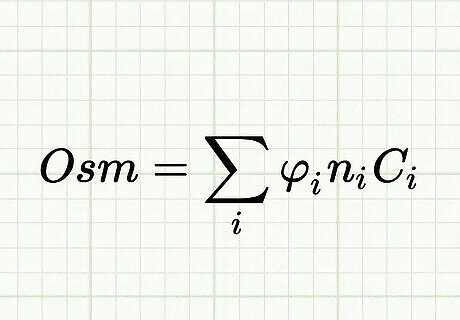
Osmolarity is the number of particles divided by the liters of a solution. Osmolarity is the number of osmoles (or milliosmoles), or the concentration of all the ions, in 1 liter of a solution. To calculate the osmolarity of a solution with 1 solute, convert the data given to Osmol/L using this basic formula: Osmolarity = (value given) x (molarity of solute) x (# of particles dissociated from solute) This formula can also be written as: mOsmol/L = (weight of substance (g/L) / molecular weight of substance (AMU or g)) x (# of particles dissociated) x 1000 To calculate the osmolarity of blood, use the equation: Osmolarity = (Sodium x 2) + (Glucose / 18) + (BUN / 2.8).
Calculating the Osmolarity of a Solute
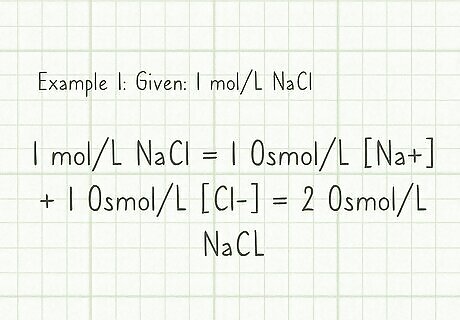
Find the osmolarity of NaCl by multiplying the value in moles by 2. When you have NaCl in a solution, it dissociates in water to form a Na+ ion and an anion (or negative ion) like Cl- or HCO3-. This means a solution with 1 mol/L NaCl has an osmolarity of 2 Osmol/L. Example 1: Given: 1 mol/L NaCl. 1 mol/L NaCl = 1 Osmol/L [Na+] + 1 Osmol/L [Cl-] = 2 Osmol/L NaCL. Example 2: Given: [Na+] = 0.140 mol/L (or 140 mEq/L). Sodium is one particle, so it doesn’t split up in water. This means mol/L equals Osmol/L. [Na+] = 0.140 Osmol/L. Each ion of Na+ pairs with Cl- to get 2 Osmol of particles. [Cl-] = 0.140 mol/L = 0.140 Osmol/L. 0.140 Osmol/L [Na+] + 0.140 Osmol/L [Cl-] = 0.280 Osmol/L NaCl. Example 3: Given: 0.15 mol/L NaCl. (0.15 mol / 1L) NaCl x (2 Osmol / 1 mol) = 0.30 Osmol/L NaCl.
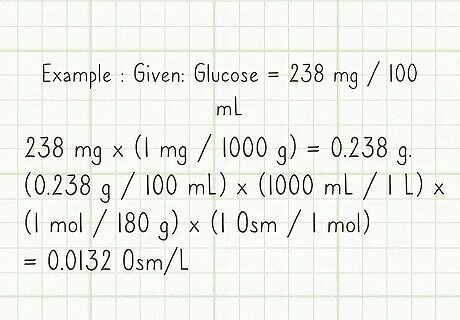
Divide the value of glucose in grams by 180 to get its osmolarity. When you add together the atomic weight of each particle in glucose (C6, H12, and O6), you get 180 atomic mass units (AMU). When you’re given the value of glucose in grams, you can divide it by 180 to get the value in moles, which can then be converted to osmoles. Example 1: Given: Glucose = 900 mg/L. Glucose is C6H12O6. To get the atomic weight (AMU) of the entire molecule, multiply each particle’s coefficient by its atomic weight on the periodic table. (6 x 12) + (12 x 1) + (6 x 16) = 180 AMU. 1 mol glucose = 180 grams. 1 mmol glucose = 180 mg. (900 mg / 1 L) x (1 mmol / 180 mg) = 5 mmol / L. 5 mmol / 1 L x (1000 mmol / 1 mol) x (1 mol / 1 Osm) = 0.005 Osm/L Glucose. Example 2: Given: Glucose = 238 mg / 100 mL. 238 mg x (1 mg / 1000 g) = 0.238 g. (0.238 g / 100 mL) x (1000 mL / 1 L) x (1 mol / 180 g) x (1 Osm / 1 mol) = 0.0132 Osm/L.
Calculating the Total Osmolarity of Plasma & Other Solutions
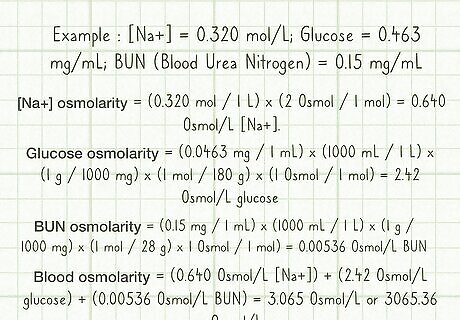
Convert the value of each solute to osmoles, then add them together. When calculating the total osmolarity of plasma (centrifuged from blood) or other solutions, convert each value given to osmoles per liter (Osm/L). Once each value is in Osm/L, add them all together to get the osmolarity of the entire solution. Example: [Na+] = 0.320 mol/L; Glucose = 0.463 mg/mL; BUN (Blood Urea Nitrogen) = 0.15 mg/mL [Na+] osmolarity = (0.320 mol / 1 L) x (2 Osmol / 1 mol) = 0.640 Osmol/L [Na+]. Glucose osmolarity = (0.0463 mg / 1 mL) x (1000 mL / 1 L) x (1 g / 1000 mg) x (1 mol / 180 g) x (1 Osmol / 1 mol) = 2.42 Osmol/L glucose. BUN osmolarity = (0.15 mg / 1 mL) x (1000 mL / 1 L) x (1 g / 1000 mg) x (1 mol / 28 g) x 1 Osmol / 1 mol) = 0.00536 Osmol/L BUN. BUN only focuses on the 2 nitrogen in the CH4N20 molecule. Since the AMU of nitrogen is 14 g, the AMU of BUN is 28 g. Blood osmolarity = (0.640 Osmol/L [Na+]) + (2.42 Osmol/L glucose) + (0.00536 Osmol/L BUN) = 3.065 Osmol/L or 3065.36 mOsmol/L.















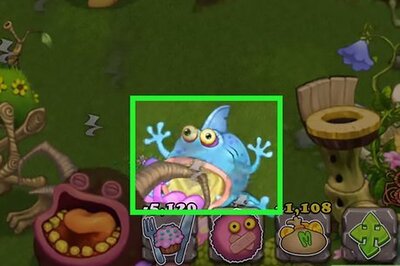
Comments
0 comment